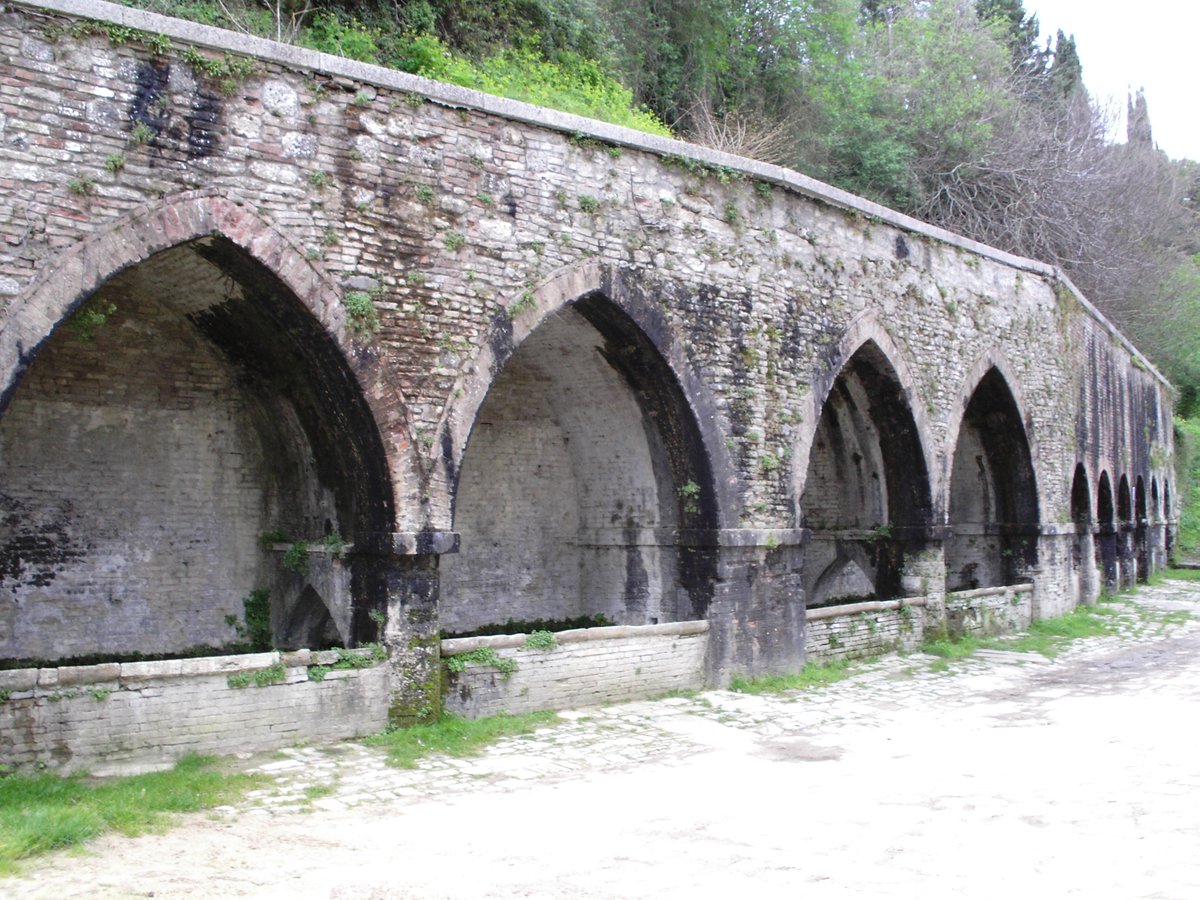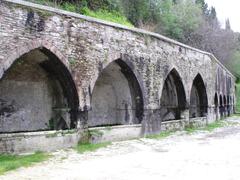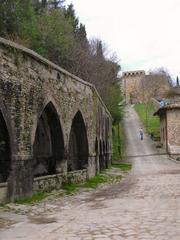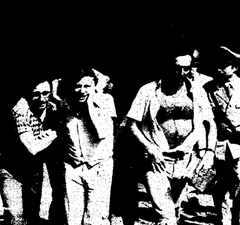
Fonti Medievali Visiting Hours, Tickets, and San Gimignano Historical Sites Guide
Date: 14/06/2025
Introduction to Fonti Medievali
Nestled in the heart of San Gimignano, Italy, the Fonti Medievali (Medieval Fountains) stand as enduring symbols of the town’s medieval ingenuity, architectural prowess, and communal spirit. Constructed mainly during the 13th and 14th centuries, these monumental public fountains addressed the persistent challenge of water scarcity—a defining factor in San Gimignano’s urban evolution. Today, the Fonti Medievali offer visitors a unique glimpse into the complexities of medieval water management, urban planning, and daily life, all within the exceptional context of a UNESCO World Heritage Site (San Gimignano tourism website; UNESCO Historic Centre of San Gimignano).
This comprehensive guide explores the historical significance, architectural highlights, visitor information, conservation efforts, and practical tips for experiencing the Fonti Medievali and nearby attractions. Whether you are a history enthusiast, a cultural traveler, or a casual visitor, understanding the Fonti Medievali will enrich your journey through San Gimignano’s storied streets.
Table of Contents
- Historical Background and Urban Development
- Architectural Features of the Fonti Medievali
- Visitor Information: Plan Your Visit
- Fonti Medievali in San Gimignano’s Urban Context
- Conservation and Community Engagement
- Current Challenges and Sustainable Tourism
- Frequently Asked Questions (FAQ)
- Conclusion and Additional Resources
Historical Background and Urban Development
Early Settlement and Water Scarcity
San Gimignano’s origins date back to Etruscan and Roman times. Its strategic hilltop position along the Via Francigena, a major pilgrimage and trade route, contributed to its prosperity but also posed challenges for water access. Unlike some Tuscan towns with abundant springs, San Gimignano’s residents relied on a patchwork of wells and rainwater cisterns, with a notable monumental cistern built in the 13th century at Piazza della Cisterna (eco.museisenesi.org).
Medieval Expansion and the Birth of Public Fountains
During the 12th and 13th centuries, the town experienced significant demographic and economic growth. This expansion drove the need for a reliable communal water supply, prompting the construction of public fountains. The Fonti Medievali, strategically placed outside the Porta delle Fonti, utilized natural springs and gravity-fed systems to provide water for residents, livestock, and local industries (eco.museisenesi.org; italyguides.it).
Architectural Features of the Fonti Medievali
The Fonti Medievali comprise a sequence of ten stone arches—six Romanesque and four Gothic—spanning a series of basins built into the hillside (Evendo). The structure’s design reflects advanced medieval engineering, with the older sections dating from the 12th century and later Gothic additions from the 14th century (casavacanze.poderesantapia.com).
Key architectural features include:
- Material and Construction: Locally sourced limestone and sandstone, assembled with lime mortar and waterproof cocciopesto lining.
- Functional Zoning: Separate basins for drinking water, livestock, laundry, and industrial use (notably tanning and textile production).
- Decorative Details: Modest carvings, moldings, and incised signatures from medieval artisans.
- Defensive Integration: Enclosed by high stone walls and positioned outside the city walls for both strategic and hygienic reasons.
These design choices testify to a sophisticated understanding of urban infrastructure and public health (1xmarketing).
Visitor Information: Plan Your Visit
Opening Hours
- Fountains: Open to the public year-round, generally accessible from 8:00 AM to 7:00 PM (hours may vary seasonally; check the official tourism website for updates).
Tickets and Admission
- Entry: Free of charge; no tickets are needed for independent visits.
- Guided Tours: Available through local operators and tourism offices; some tours may require advance booking and tickets.
Accessibility
- The site is a short walk from the town center, near Porta delle Fonti, and is reached via cobblestone paths and gentle slopes. Some areas may be challenging for wheelchair users and visitors with limited mobility.
Getting There and Nearby Attractions
- Directions: Reachable on foot from Piazza della Cisterna and other central landmarks.
- Nearby Sites: Piazza della Cisterna, San Gimignano’s towers, artisan shops, Porta delle Fonti, and the Via Francigena pilgrimage route.
Tips for Visitors
- Best Times: Early morning or late afternoon for tranquility and optimal lighting.
- Etiquette: Do not climb on the stonework; respect the site and keep it clean.
- Photography: The arches and water basins offer excellent subject matter, especially in golden hour light.
Fonti Medievali in San Gimignano’s Urban Context
The Fonti Medievali are integral to the town’s historical landscape. Their location near major gates and the ancient Via Francigena underscores their civic and symbolic roles (Evendo). The fountains provided a gathering space for daily chores, social interaction, and even religious rites, as depicted in medieval frescoes (San Gimignano UNESCO Criteria).
Their harmonious integration with San Gimignano’s towers, walls, and urban fabric makes them a highlight on heritage walks and thematic itineraries, including routes focused on Dante and other historical figures.
Conservation and Community Engagement
Preservation Initiatives
As part of the UNESCO World Heritage-listed Historic Centre, the Fonti Medievali benefit from rigorous conservation and restoration programs. These efforts focus on stabilizing stonework, maintaining water channels, and preserving original features such as medieval inscriptions and basins (UNESCO San Gimignano).
Community Involvement
Local organizations and educational programs actively promote stewardship of the fountains. Residents participate in interpretive walks, festivals, and heritage events that highlight the significance of water management in the town’s history (Passeggiata Patrimoniale).
Current Challenges and Sustainable Tourism
Tourism Pressure
The popularity of San Gimignano brings both economic benefits and challenges, including increased wear, crowding, and maintenance needs at the Fonti Medievali. The municipality implements measures such as visitor flow management and educational signage to encourage responsible tourism (UNESCO San Gimignano).
Environmental and Structural Risks
The fountains face risks from weathering, moss, and water infiltration, all exacerbated by climate change. Continued funding and technical expertise remain essential for ongoing preservation (UNESCO Documentation).
Urban Development and Community Sustainability
Balancing modernization with conservation is a priority. Efforts to maintain affordable housing and community cohesion are critical to sustaining local stewardship.
Frequently Asked Questions (FAQ)
Q: What are the Fonti Medievali visiting hours?
A: Open year-round, typically from 8:00 AM to 7:00 PM. Hours for guided tours may vary by season.
Q: Is there an entrance fee?
A: No, independent visits are free. Some guided tours may require a ticket.
Q: Are the fountains wheelchair accessible?
A: The approach includes cobblestones and slopes; accessibility is partial. Check with the tourism office for assistance.
Q: Can I drink the water from the fountains?
A: No, the water is not potable.
Q: Are guided tours available?
A: Yes, guided tours can be reserved through local providers and the tourism office.
Q: How do I get to the Fonti Medievali from the town center?
A: The fountains are a short walk from Piazza della Cisterna, signposted near Porta delle Fonti.
Conclusion and Additional Resources
The Fonti Medievali of San Gimignano are a must-see for anyone interested in medieval architecture, social history, or simply seeking a tranquil escape from the town’s bustling squares. Their enduring presence and ongoing conservation efforts offer a tangible connection to Tuscany’s rich past. By respecting visitor guidelines and supporting local initiatives, you contribute to the preservation of this remarkable site.
For further reading, guided audio tours, and real-time visitor updates, download the Audiala app and consult the links below.
Official and Recommended Resources:
- San Gimignano Official Tourism Website
- Fonti Medievali San Gimignano: Historical Guide
- Fonti Medievali San Gimignano: Attraction Overview
- UNESCO: Historic Centre of San Gimignano
- Passeggiata Patrimoniale Itinerary


